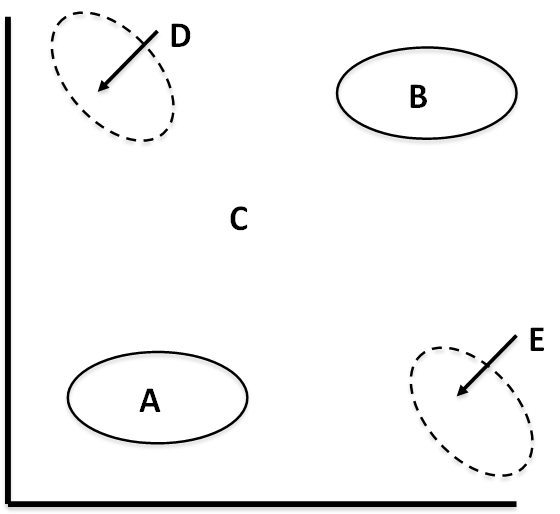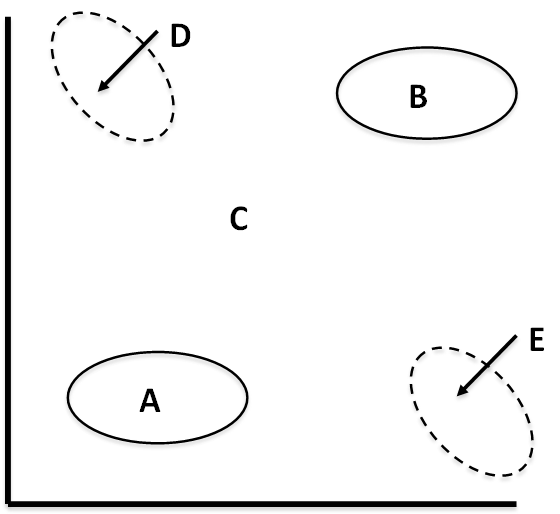B) False
Correct Answer

verified
Correct Answer
verified
Short Answer
 In the accompanying figure, which region represents stars that are extremely bright and emit most of their radiation as ultraviolet light? Note: (C) represents the entire main sequence while (D) and (E) represent only small parts of the main sequence?
In the accompanying figure, which region represents stars that are extremely bright and emit most of their radiation as ultraviolet light? Note: (C) represents the entire main sequence while (D) and (E) represent only small parts of the main sequence?
Correct Answer

verified
Correct Answer
verified
Multiple Choice
The Balmer series of hydrogen absorption lines in stars is located in what part of the electromagnetic spectrum?
A) gamma ray region
B) ultraviolet region
C) visible region
D) infrared region
E) microwave region
G) A) and E)
Correct Answer

verified
Correct Answer
verified
True/False
S tars of low luminosity will always have large positive absolute magnitude.
B) False
Correct Answer

verified
Correct Answer
verified
Essay
A star has a parallax angle of 0.019 seconds of arc. How far away is this star from Earth?
Correct Answer

verified
Correct Answer
verified
Multiple Choice
In which spectral sequence are the hottest stars categorized?
A) O stars
B) B stars
C) A stars
D) F stars
E) K stars
G) C) and E)
Correct Answer

verified
Correct Answer
verified
Short Answer
Th e apparen t magnitud e o f a sta r observe d fro m a distanc e o f 1 0 pc is called _____.
Correct Answer

verified
absolute v...View Answer
Show Answer
Correct Answer
verified
View Answer
Essay
Explain why it would be better to obtain stellar parallax for stars if we could observe from the planet Mars instead of the Earth.
Correct Answer

verified
Observing from Mars would give us a long...View Answer
Show Answer
Correct Answer
verified
View Answer
Multiple Choice
 The sloped lines from top left to bottom right in the accompanying figure are labeled ____.
The sloped lines from top left to bottom right in the accompanying figure are labeled ____.
A) temperature
B) radius
C) apparent magnitude
D) absolute magnitude
E) mass
G) A) and B)
Correct Answer

verified
Correct Answer
verified
Multiple Choice
Which star has the highest density (mass per unit volume) ?
A) white dwarf
B) main sequence
C) supergiant
D) red giant
E) regular giant
G) B) and D)
Correct Answer

verified
Correct Answer
verified
True/False
The luminosity class is assigned to a star by studying the absorption lines in the spectrum of the star.
B) False
Correct Answer

verified
Correct Answer
verified
Multiple Choice
 The horizontal axis in the accompanying figure is labeled _____.
The horizontal axis in the accompanying figure is labeled _____.
A) temperature
B) radius
C) apparent magnitude
D) absolute magnitude
E) luminosity
G) B) and D)
Correct Answer

verified
Correct Answer
verified
Multiple Choice
Recent discoveries of two types of brown dwarfs have placed these stars near which spectral type of star?
A) hotter than O stars
B) cooler than O stars
C) hotter than M stars
D) cooler than M stars
E) at exactly the same level as G stars
G) C) and E)
Correct Answer

verified
Correct Answer
verified
True/False
All stars produce an absorption spectra.
B) False
Correct Answer

verified
Correct Answer
verified
Short Answer
If luminosity depends on radius and temperature, what does flux depend on? _______________
Correct Answer

verified
Correct Answer
verified
Short Answer
The most common stars are _______________ stars.
Correct Answer

verified
lower-main...View Answer
Show Answer
Correct Answer
verified
View Answer
Multiple Choice
Which star has the largest diameter?
A) white dwarf
B) main sequence
C) red giant
D) supergiant
E) regular giant
G) A) and E)
Correct Answer

verified
Correct Answer
verified
True/False
Recently discovered brown dwarfs have spectra similar to cool O-type stars.
B) False
Correct Answer

verified
Correct Answer
verified
Multiple Choice
Remember Kepler's third law, which relates the period of revolution to the average distance to a planet. How do we modify that law to use with binary stars?
A) Add the total mass of the two stars.
B) Add Newton's Law of Gravitation.
C) Add Einstein's Law of Relativity.
D) Add the difference of their masses.
E) Add the distance between the two stars.
G) A) and E)
Correct Answer

verified
Correct Answer
verified
Multiple Choice
The stellar parallax limit for ground-based telescopes is accurate for stars closer than ____.
A) 10 parsecs
B) 50 parsecs
C) 100 parsecs
D) 200 parsecs
E) 500 parsecs
G) A) and B)
Correct Answer

verified
Correct Answer
verified
Showing 41 - 60 of 70
Related Exams